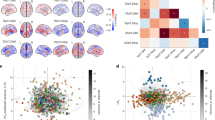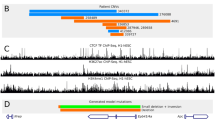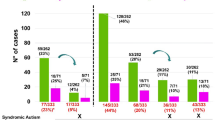Abstract
Genome-wide screening for copy number variations (CNVs) in ten Indian dyslexic families revealed the presence of five de novo CNVs in regions harboring GABARAP, NEGR1, ACCN1, DCDC5, and one in already known candidate gene CNTNAP2. These genes are located on regions of chromosomes 17p13.1, 1p31.1, 17q11.21, 11p14.1 and 7q35, respectively, and are implicated in learning, cognition and memory processes through dendritic spinal plasticity, though not formally associated with dyslexia. Molecular network analysis of these and other dyslexia-related module genes suggests them to be associated with synaptic transmission, axon guidance and cell adhesion. Thus, we suggest that dyslexia may also be caused by neuronal disconnection in addition to the earlier view that it is due to neuronal migrational disorder.
Similar content being viewed by others
Log in or create a free account to read this content
Gain free access to this article, as well as selected content from this journal and more on nature.com
or
References
Grigorenko, E. L., Wood, F. B., Meyer, M. S. & Pauls, D. L. Chromosome 6p influences on different dyslexia-related cognitive processes: further confirmation. Am. J. Hum. Genet. 66, 715–723 (2000).
Katusic, S. K. Incidence of reading disability in a population-based birth cohort, 1976-1982, Rochester, Minn. Mayo Clin. Proc. 76, 1081–1092 (2001).
Scerri, T. S. & Schulte-Korne, G. Genetics of developmental dyslexia. Eur. Child Adolesc. Psychiatry 19, 179–197 (2010).
Estivill, X. & Armengo, L. Copy number variants and common disorders: filling the gaps and exploring complexity in genome-wide association studies. PLoS Genet 3, 1787–1799 (2007).
Conrad, D. F., Pinto, D., Redon, R., Feuk, L., Gokcumen, O., Zhang, Y. et al. Origins and functional impact of copy number variation in the human genome. Nature 464, 704–712 (2010).
Freeman, J. L., Perry, G. H., Feuk, L., Redon, R., McCarroll, S. A., Altshuler, D. M. et al. Copy number variation: new insights in genome diversity. Genome Res. 16, 949–961 (2006).
Aitman, T. J., Dong, R., Vyse, T. J., Norsworthy, P. J., Johnson, M. D., Smith, J. et al. Copy number polymorphism in Fcgr3 predisposes to glomerulonephritis in rats and humans. Nature 439, 851–855 (2006).
Wagenstaller, J., Spranger, S., Lorenz-Depiereux, B., Kazmierczak, B., Nathrath, M., Wahl, D. et al. Copy-number variations measured by single-nucleotide-polymorphism oligonucleotide arrays in patients with mental retardation. Am. J. Hum. Genet. 81, 768–779 (2007).
Sebat, J., Lakshmi, B., Malhotra, D., Troge, J., Lese-Martin, C., Walsh, T. et al. Strong association of de novo copy number mutations with autism. Science 316, 445–449 (2007).
Alarcon, M., Abrahams, B. S., Stone, J. L., Duvall, J. A., Perederiy, J. V., Bomar, J. M. et al. Linkage, association, and gene-expression analyses identify CNTNAP2 as an autism-susceptibility gene. Am. J. Hum. Genet. 82, 150–159 (2008).
Marshall, C. R., Noor, A., Vincent, J. B., Lionel, A. C., Feuk, L., Skaug, J. et al. Structural variation of chromosomes in autism spectrum disorder. Am. J. Hum. Genet. 82, 477–488 (2008).
Tam, G. W., Redon, R., Carter, N. P. & Grant, S. G. The role of DNA copy number variation in schizophrenia. Biol. Psychiatry 66, 1005–1012 (2009).
Kirov, G. The role of copy number variation in schizophrenia. Expert Rev. Neurother. 10, 25–32 (2010).
Walsh, T., McClellan, J. M., McCarthy, S. E., Addington, A. M., Pierce, S. B., Cooper, G. M. et al. Rare structural variants disrupt multiple genes in neurodevelopmental pathways in schizophrenia. Science 320, 539–543 (2008).
Need, A. C., Ge, D., Weale, M. E., Maia, J., Feng, S., Heinzen, E. L. et al. A genome-wide investigation of SNPs and CNVs in schizophrenia. PLoS Genet. 5, 120–127 (2009).
Peter, B., Raskind, W. H., Matsushita, M., Lisowski, M., Vu, T., Berninger, V. W. et al. Replication of CNTNAP2 association with nonword repetition and support for FOXP2 association with timed reading and motor activities in a dyslexia family sample. J. Neurodevelop Disord. 3, 39–49 (2011).
Oldfield, R. C. The assessment and analysis of handedness: the Edinburgh inventory. Neuropsychologia 9, 97–113 (1971).
Birdsuite Algorithm Http://www.broad.mit.edu/mpg/birdsuite/birdseed.html (2010).
White Paper: AffymetrixCanary Algorithm Version 1.0., 1-7 (2008).
The analysis for this paper was generated using Array Studio software. Array Studio, Array Viewer and Array Server and all other Omicsoft products or service names are registered trademarks or trademarks of Omicsoft Corporation., Research Triangle Park, NC, USA.
Price, A. L., Patterson, N. J., Plenge, R. M., Weinblatt, M. E., Shadick, N. A. & Reich, D. Principal components analysis corrects for stratification in genome-wide association studies. Nat. Genet. 38, 904–909 (2006).
The International HapMap Consortium. The International HapMap Project. Nature 426, 789–796 (2003).
Simonson, T. S., Yang, Y., Huff, C. D., Yun, H., Qin, G., Witherspoon, D. J. et al. Genetic evidence for high-altitude adaptation in Tibet. Science 329, 72–75 (2010).
Warde-Farley, D., Donaldson, S. L., Comes, O., Zuberi, K., Badrawi, R., Chao, P. et al. The GeneMANIA prediction server: biological network integration for gene prioritization and predicting gene function. Nucleic Acids Res. 1, 38–45 (2010).
Girirajan, S., Brkanac, Z., Coe, B. P., Baker, C., Vives, L., Vu, T. H. et al. Relative burden of large CNVs on a range of neurodevelopmental phenotypes. PLoS Genet. 7, e1002334 (2011).
Coyle, J. E., Qamar, S., Rajashankar, K. R. & Nikolov, D. B. Structure of GABARAP in two conformations: implications for GABA (A) receptor localization and tubulin binding. Neuron 33, 63–74 (2002).
Chen, Z., Chang, C. S., Leil, T. A. & Olsen, R. W. C-terminal modification is required for GABARAP mediated GABAA receptor trafficking. J. Neurosci. 27, 6655–6663 (2007).
Collinson, N., Kuenzi, F. M., Jarolimek, W., Maubach, K. A., Cothliff, R., Sur, C. et al. Enhanced learning and memory and altered GABAergic synaptic transmission in mice lacking the α5 subunit of the GABAA receptor. J. Neurosci. 22, 5572–5580 (2002).
Mohler, H. Molecular regulation of cognitive functions and developmental plasticity: impact of GABAA receptors. J. Neurochem. 102, 1–12 (2007).
Mohler, H. Role of GABAA receptors in cognition. Biochem. Soc. Trans. 37, 1328–1333 (2009).
Lewis, D. A., Cho, R. Y., Carter, C. S., Eklund, K., Forster, S., Kelly, M. A. et al. Subunit-selective modulation of GABA type A receptor neurotransmission and cognition in schizophrenia. Am. J. Psychiatry 165, 1585–1593 (2008).
Komoike, Y., Shimojima, K., Liang, J. S., Fujii, H., Maegaki, Y., Osawa, M. et al. A functional analysis of GABARAP on 17p13.1 by knockdown zebrafish. J. Hum. Genet. 55, 155–162 (2010).
Hashimoto, T., Yamada, M., Maekawa, S., Nakashima, T. & Miyata, S. IgLON. Cell adhesion molecule Kilon is a crucial modulator for synapse number in hippocampal neurons. J.Brain Res. 1224, 1–11 (2008).
Alvarez, V. A. & Sabatini, B. L. Anatomical and physiological plasticity of dendritic spines. Annu. Rev. Neurosci. 30, 79–97 (2007).
Gillberg, C. & FitzPatrick, D. Case report: further evidence for a recognizable syndrome caused by deletion of 1p31. Adv. Clin. Neurosci. Rehabil. 3, 16–18 (2010).
Wemmie, J. A., Chen, J., Askwith, C. C., Hruska-Hageman, A. M., Price, M. P., Nolan, B. C. et al. The acid activated ion channel ASIC contributes to synaptic plasticity, learning, and memory. Neuron 34, 463–477 (2002).
Riva, P., Corrado, L., Natacci, F., Castorina, P., Wu, B. L., Schneider, G. H. et al. NF1 microdeletion syndrome: refined FISH characterization of sporadic and familial deletions with locus-specific probes. Am. J. Hum .Genet. 66, 100–109 (2000).
Caselli, R., Ballarati, L., Selicorni, A., Milani, D., Maitz, S., Valtorta, C. et al. A 12.4 Mb duplication of 17q11.2q12 in a patient with psychomotor developmental delay and minor anomalies. Eur. J. Med. Genet. 53, 325–328 (2010).
Meng, H., Smith, S. D., Hager, K., Held, M., Liu, J., Olson, R. K. et al. DCDC2 is associated with reading disability and modulates neuronal development in the brain. Proc. Natl Acad. Sci. USA 102, 7053–7058 (2005).
Strauss, K. A., Puffenberger, E. G., Huentelman, M. J., Gottlieb, S., Dobrin, S. E., Parod, J. M. et al. Recessive symptomatic focal epilepsy and mutant contactin-associated protein-like 2. N Engl. J. Med. 354, 1370–1377 (2006).
Groszer, M., Keays, D. A., Deacon, R. M., de Bono, J. P., Prasad-Mulcare, S., Gaub, S. et al. Impaired synaptic plasticity and motor learning in mice with a point mutation implicated in human speech deficits. Curr. Biol. 18, 354–362 (2008).
Zweier, C., de Jong, E. K., Zweier, M., Orrico, A., Ousager, L. B., Collins, A. L. et al. CNTNAP2 and NRXN1 are mutated in autosomal-recessive Pitt-Hopkins-like mental retardation and determine the level of a common synaptic protein in Drosophila. Am. J. Hum. Genet. 85, 655–666 (2009).
Yoshihara, Y., Kawasaki, M., Tamada, A., Nagata, S., Kagamiyama, H., Mori, K. et al. Overlapping and differential expression of BIG-2, BIG-1, TAG-1, and F3: four members of an axon-associated cell adhesion molecule subgroup of the immunoglobulin superfamily. J. Neurobiol. 28, 51–69 (1995).
Levitt, P. A monoclonal antibody to limbic system neurons. Science 223, 299–301 (1984).
Pimenta, A. F., Reinoso, B. S. & Levitt, P. Expression of the mRNAs encoding the limbic system-associated membrane protein (LAMP): II. Fetal rat brain. J. Comp. Neurol. 375, 289–302 (1996).
Struyk, A. F., Canoll, P. D., Wolfgang, M. J., Rosen, C. L., D'Eustachio, P., Salzer, J. L. et al. Cloning of neurotrimin defines a new subfamily of differentially expressed neural cell adhesion molecules. J. Neurosci. 15, 2141–2156 (1995).
Funatsu, N., Miyata, S., Kumanogoh, H., Shigeta, M., Hamada, K., Endo, Y. et al. Characterization of a novel rat brain glycosylphosphatidylinositol-anchored protein (Kilon), a member of the IgLON cell adhesion molecule family. J. Biol. Chem. 274, 8224–8230 (1999).
Zuo, A. L., Chang, P. & Gan, W. B. Development of long-term dendritic spine stability in diverse regions of cerebral cortex. Neuron 46, 181–189 (2005).
Holtmaat, A. J., Trachtenberg, J. T., Wilbrecht, L., Shepherd, G. M., Zhang, X., Knott, G. W. et al. Transient and persistent dendritic spines in the neocortex in vivo. Neuron 45, 279–291 (2005).
Yang, G., Pan, F. & Gan, W. B. Stably maintained dendritic spines are associated with lifelong memories. Nature 462, 920–924 (2009).
Xu, T., Yu, X., Perlik, A. J., Tobin, W. F., Zweig, J. A., Tennant, K. et al. Rapid formation and selective stabilization of synapses for enduring motor memories. Nature 462, 915–919 (2009).
Klamt, S. Generalized concept of minimal cut sets in biochemical networks. BioSystems 83, 233–247 (2006).
Rutter, M. Children’s behavior questionnaire for completion by teachers; preliminary findings. J. Child Psy. Pry 8, 1–11 (1967).
Raven, J., Raven, J. C. & Court, J. H. Manual for Raven's Standard Progressive Matrices And Vocabulary Scales, (San Antonio, TX, USA: Pearson, 2000).
Karanth, P. Analysis of acquired disorders of reading in Kannada. JAAISH XV, 65–75 (1984).
Jayabai, K. “Standardization of Kannada Oral Reading Test For Primary School”. An Unpublished MSc. Thesis, (University of Mysore: Mysore, India, 1958).
Rao, C. Reading and Writing in Kannada and English orthographies: A Psycholinguistic Investigation of Processes, Problems and Remedial Measure. Doctoral Thesis, (University of Mysore: Mysore, India, 2004).
Padakannaya, P. Battery of phonological tests. Department of Psychology, (University of Mysore: Mysore, India, 1999).
Denckla, M. B. & Rudel, R. Rapid "Automatized" naming of pictures, objects, colors, and letters, and numbers by normal children. Cortex 10, 186–202 (1974).
Acknowledgements
We thank the funding agency the Department of Science and Technology-Health Science (SR/SO/HS-103/2007), Government of India, New Delhi; the subjects and their families for participating in this study; Prof. H A Ranganath for his help and encouragement; Anand S and Shyamala KV for their help in sample collection; and Mr Surendranath Nishanimutt of Samveda Research and Training Institute, Davangere for providing samples; services of Vimta Labs Ltd., and also the University of Mysore for providing facility to conduct this work.
Author information
Authors and Affiliations
Corresponding author
Ethics declarations
Competing interests
The authors declare no conflict of interest.
Additional information
Supplementary Information accompanies the paper on Journal of Human Genetics website
Rights and permissions
About this article
Cite this article
Veerappa, A., Saldanha, M., Padakannaya, P. et al. Family-based genome-wide copy number scan identifies five new genes of dyslexia involved in dendritic spinal plasticity. J Hum Genet 58, 539–547 (2013). https://doi.org/10.1038/jhg.2013.47
Received:
Revised:
Accepted:
Published:
Issue date:
DOI: https://doi.org/10.1038/jhg.2013.47
Keywords
This article is cited by
-
A systematic review of associations between genetic polymorphism and dyslexia in the Indian population
Journal of Biosciences (2022)
-
Neural cell adhesion molecule Negr1 deficiency in mouse results in structural brain endophenotypes and behavioral deviations related to psychiatric disorders
Scientific Reports (2019)
-
In silico approach to identify non-synonymous SNPs with highest predicted deleterious effect on protein function in human obesity related gene, neuronal growth regulator 1 (NEGR1)
3 Biotech (2018)
-
Neurogenetics of developmental dyslexia: from genes to behavior through brain neuroimaging and cognitive and sensorial mechanisms
Translational Psychiatry (2017)
-
Investigating the effects of copy number variants on reading and language performance
Journal of Neurodevelopmental Disorders (2016)



